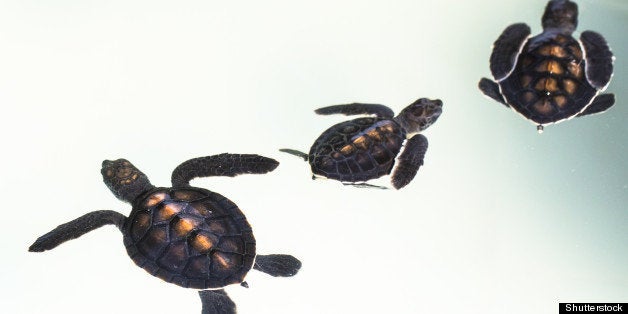
Like summer, turtle hatching season is coming to a close on Hatteras Island, and all along the coast, sunbathers incubate themselves in late summer heat, under strategically planted umbrellas that skirt dozens of fenced nesting areas. Only feet away, just under the surface, the eggs of five turtle species slowly mature, a process that has endured since the dinosaurs.
That cycle almost came to a crashing halt. In humanity's short reign, overfishing drove sea turtles almost to extinction -- Churchill's favorite meal was sea turtle soup -- and today ocean gyres of plastic kill still more. These protected nesting sites are an attempt to bring them back.
Bobbing in the waves, my daughter Willa wondered why. "What does it matter if a turtle goes extinct?" I defaulted to the old saws: the value to humans, medicine, ecology. I told her we're using the psychedelic blue blood of an even older animal, horseshoe crabs, in medicine. Who knows how we might use turtles? I mentioned the risk to the food chain, the role of "indicator species" that act as barometers for broader ecosystem health. But those arguments seemed weak, embarrassingly self-serving, and reeked of rationalization. In the end, for all our flaws as humans, I told her, we just can't bear to see these animals go away after thriving for 100 million years. That instinct, I say, has got to be the most remarkable thing about us: It is a miracle that we care.
But we do. News about turtle activity spread like a storm surge across the beaches of North Carolina, an underground network, a black market in turtle intel. Near our s'mores fire one night, my wife learned of an unannounced excavation the next day. When we arrived at what we thought was a secret event, we found forty others.
A ponytailed National Park Service biologist with his fly charmingly undone sweated through his uniform describing turtle biology -- they swim out to sea to catch the gulf stream ("Just like in Finding Nemo!" a kid yells). The males never return, the females come back 30 years later to lay their eggs. We learned that a nearby nest was likely to "boil" in the next few days. That night, we visited the site, Willa and me, my wife and daughter. There too, we found throngs.
Turtle mania had hit the beaches! Info on excavations spread not through Twitter or Instagram, but though the oldest form of human contact -- schmoozing -- and it went viral like the latest sex tape or reality show. (Though, I admit, this too is a reality show and a sex tape, of sorts.) One Ohio couple spent six nights up until midnight waiting for the eggs to hatch.
The biologist explained that other causes of turtle mortality are massive beach rebuilding projects that pump sand off the continental shelf. These efforts to at least forestall the impact of another human screwed-up -- the climate -- also kills turtles, even while it restores some of the nesting sites eroded by sea level rise and superstorms. We can't win for losing, it seems.
Perhaps turtle mania is a sign we've had enough. Despite our society's obsession with the inane and vapid, when offered something utterly and beautifully important, something that fulfills the ancient Hebrew notion of Tikkun Olam, the obligation to repair God's creation, we can't resist. Donald Trump and the Kardashians are interesting, I guess, but loggerheads and leatherbacks have soul. On the night of the boil, our son Elias refused to go to bed, insisting we stay late, his own instincts as inexplicable and deeply rooted as the internal compass that pulls hatchlings into the sea.
From 8:30 to 10, a group of about 15 milled around, fighting the occasional mosquito and, for the Ohioans at least, the sense that their vacation would end with nothing to show for their waiting. And then the ground broke. A silver dollar-sized hatchling groveled out of the earth in the dull red of an infrared light. And then another, and then 88 more. Guided by the moonlight and the helpful flashlight of a volunteer, they crawled slowly into the ocean to face the longest of possible odds -- only one in 1000 will survive.
Their odds are low, but they couldn't be much lower than the chance that we'd care about them at all. And they are higher than the likelihood we'd put down our devices, and for a waning summer moment, focus on our species' earnest, halting, and late efforts to put one part of the world back together.